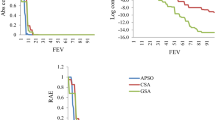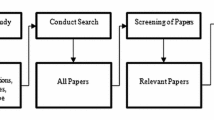Abstract
Metaheuristics are algorithms that are used to solve difficult optimization problems. They are typically stochastic approaches; hence, proper statistical tests are needed to compare them. However, choosing an appropriate statistical test is not trivial given that each test requires some assumptions to be true before the test can be used. Moreover, the p-values associated with a statistical test is usually difficult to interpret. In this paper, we propose the use of Laplace’s rule of succession to compare different metaheuristic approaches. The rule is simple, intuitive and easy to compute. It can be used alone or to complement a statistical test. The process of using the rule for comparison purposes is clearly explained and applied to a typical scenario encountered in the field of metaheuristics. In this scenario, an improved variant of an existing metaheuristic algorithm is proposed. To evaluate the performance of the two algorithms, Laplace’s rule and a traditional statistical test are used. Analysis of the results and how to interpret them are provided. The results show that Laplace’s rule is consistent with the used statistical test. Furthermore, the rule is easier to compute and interpret.




Similar content being viewed by others
Data Availability
The datasets generated during and/or analyzed during the current study are available from the corresponding author on reasonable request.
Notes
A Notebook document with the code and results can be requested from the corresponding author.
The classical Pearson’s correlation coefficient evaluates how much the relationship is linear. Actually, it is also strong on this small benchmark set and these algorithms A and B. However, the Spearman’s rank correlation is more general and robust.
References
Beyer H, Schwefel H (2002) Evolution strategies: A comprehensive introduction. Natural Comput 1(1):3–52
Maurice Clerc (2021) MAMSO (Multi-agents multi-strategies optimiser). https://hal.archives-ouvertes.fr/hal-03150719
Dorigo M, Stützle T (2019) Ant colony optimization: overview and recent advances. Springer International Publishing, Cham, pp 311–351
dos Santos Coelho L, Mariani VC (2008) Use of chaotic sequences in a biologically inspired algorithm for engineering design optimization. Expert Syst Appl 34(3):1905–1913
Friedman M (1937) The use of ranks to avoid the assumption of normality implicit in the analysis of variance. J Am Stat Assoc 32(200):675–701
Goldberg D (1989) Genetic algorithms in search. Optimization and Machine Learning. Addison-Wesley Professional, Boston
Gosset W (1908) The probable error of a mean. Biometrika 6(1):1–25
Eghbal H, Kayhan Zrar G, Ali E, Ali Safaa S, Danda BR (2021) Novel metaheuristic based on multiverse theory for optimization problems in emerging systems. Appl Intell 51(6):3275–3292
Heidari AA, Mirjalili S, Faris H, Aljarah I, Mafarja M, Chen H (2019) Harris hawks optimization: Algorithm and applications. Future Gener Comput Syst 97:849–872
Han Fei, Zheng Mingpeng, Ling Qinghua (2022) An improved multiobjective particle swarm optimization algorithm based on tripartite competition mechanism. Appl Intell 52(5):5784–5816
Kayhan AH, Ceylan H, Ayvaz MT, Gurarslan G (2010) Psolver: A new hybrid particle swarm optimization algorithm for solving continuous optimization problems. Expert Syst Appl 37(10):6798–6808
Kennedy J, Eberhart R(1995) Particle swarm optimization. In: IEEE international conference on neural networks, pp 1942–1948. IEEE
Laplace P (1814) Essai philosophique sur les probabilités. Courcier, Paris
Li S, Chen H, Wang M, Heidari AA, Mirjalili S (2020) Slime mould algorithm: A new method for stochastic optimization. Future Gener Comput Syst 111:300–323
Misuse of p-values (2022) Misuse of \(p\)-values—Wikipedia, the free encyclopedia, [Online; accessed 10-June-2022]
Rao RV (2016) Jaya: A simple and new optimization algorithm for solving constrained and unconstrained optimization problems. Int J Ind Eng Comput 7(1):19–34
Skiena S (2017) The data science design manual. Springer, Berlin
Storn R, Price K (1995) Differential evolution-a simple and efficient adaptive scheme for global optimization over continuous spaces. ICSI, Technical report, Berkeley
Stigler S (1986) The history of statistics: the measurement of uncertainty before 1900. Belknap Press of Harvard University Press, Cambridge
Wilcoxon Frank (1945) Individual comparisons by ranking methods. Biomet Bull 1(6):80–83
Yang X-S (2014) Nature-inspired optimization algorithms. Elsevier, Amsterdam
Zhong Xuxu, Cheng Peng (2021) An elite-guided hierarchical differential evolution algorithm. Appl Intell 51(7):4962–4983
Acknowledgements
The authors would like to thank the anonymous reviewers for their constructive and helpful comments and suggestions. This work was supported by Gulf University for Science and Technology (Kuwait) under Grant 251896.
Author information
Authors and Affiliations
Corresponding author
Ethics declarations
Conflicts of interest
The authors of this article certify that they have NO affiliations with or involvement in any organization or entity with any financial interest or non-financial interest in the subject matter or materials discussed in this manuscript.
Additional information
Publisher's Note
Springer Nature remains neutral with regard to jurisdictional claims in published maps and institutional affiliations.
Rights and permissions
Springer Nature or its licensor (e.g. a society or other partner) holds exclusive rights to this article under a publishing agreement with the author(s) or other rightsholder(s); author self-archiving of the accepted manuscript version of this article is solely governed by the terms of such publishing agreement and applicable law.
About this article
Cite this article
Omran, M.G.H., Clerc, M. Laplace’s rule of succession: a simple and efficient way to compare metaheuristics. Neural Comput & Applic 35, 11807–11814 (2023). https://doi.org/10.1007/s00521-023-08322-5
Received:
Accepted:
Published:
Issue Date:
DOI: https://doi.org/10.1007/s00521-023-08322-5




